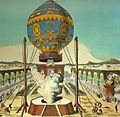Aeronautics facts for kids
Aeronautics is the exciting study of how things fly. It's all about designing, building, and flying machines like airplanes and helicopters. The word "aeronautics" comes from ancient Greek words meaning "air navigating."
A big part of aeronautics is Aerodynamics. This is the science of how air moves around objects. It helps us understand how wings create lift and how planes can fly through the sky. Aeronautics is closely linked to transport and engineering. Aerodynamics is a branch of science.
Contents
What is Aeronautics?
Aeronautics covers everything related to flight within Earth's atmosphere. This includes the science, engineering, and operation of aircraft. It's a field that combines many different subjects.
- Science: Understanding how air behaves and how forces like lift and drag work.
- Engineering: Designing and building aircraft, engines, and flight control systems.
- Operation: Learning how to fly planes, manage air traffic, and maintain aircraft.
This field helps us travel faster and explore new places. It also plays a big role in things like delivering goods and even helping with rescue missions.
How Do Things Fly?
Flying machines work because of four main forces:
- Lift: This is the upward force that pushes an aircraft into the sky. Wings are shaped to create lift as air flows over them.
- Weight: This is the downward force of gravity pulling the aircraft towards Earth. To fly, lift must be greater than weight.
- Thrust: This is the forward force that moves the aircraft through the air. Engines create thrust.
- Drag: This is the backward force that resists the aircraft's movement. It's caused by air friction.
Engineers work hard to design planes that have enough lift and thrust to overcome their weight and drag.
Types of Flying Machines
Aeronautics deals with many different types of aircraft. Each one is designed for a special purpose.
- Airplanes: These have fixed wings and use engines to create thrust. They are used for travel, cargo, and even military purposes.
- Helicopters: These use spinning blades called rotors to create lift. They can hover in one spot and fly in any direction, making them useful for rescues and short trips.
- Gliders: These aircraft have no engine. They use air currents and their wing design to stay in the air.
- Drones: These are uncrewed aircraft. They can be controlled remotely and are used for photography, delivery, and exploration.
History of Flight
Humans have dreamed of flying for thousands of years. Early ideas included Leonardo da Vinci's designs for flying machines in the 1400s.
- Balloons: The first successful human flights were in hot air balloons. The Montgolfier brothers made their first public flight in 1783. These balloons float because the air inside them is heated, making it lighter than the air outside.
- Gliders: Pioneers like Otto Lilienthal experimented with gliders in the late 1800s. They learned a lot about wing shapes and how to control flight.
- Powered Flight: The biggest breakthrough came with the Wright brothers. On December 17, 1903, their Flyer I made the first successful controlled flight in Kitty Hawk, North Carolina. This moment changed the world forever.
Since then, aircraft have become much faster, safer, and more powerful.
Modern Aeronautics
Today, aeronautics is a huge field. It involves advanced technology and complex designs.
- Commercial Aviation: This is about passenger planes that carry millions of people around the world every day. It focuses on safety, fuel efficiency, and comfort.
- Military Aviation: This includes fighter jets, bombers, and transport planes used by armed forces. These aircraft are designed for speed, stealth, or carrying heavy loads.
- Space Exploration: While aeronautics focuses on flight within Earth's atmosphere, it's closely related to astronautics, which is the study of spaceflight. Many technologies developed for aircraft are also used in spacecraft.
Aeronautics continues to evolve. Engineers are always working on new materials, more efficient engines, and smarter flight control systems. This helps make flying even better and safer for everyone.
Related pages
Images for kids
-
Space Shuttle Atlantis on a Shuttle Carrier Aircraft.
-
The Eurofighter Typhoon.
-
Antonov An-225 Mriya, the largest aeroplane ever built.
See also
 In Spanish: Aeronáutica para niños
In Spanish: Aeronáutica para niños








